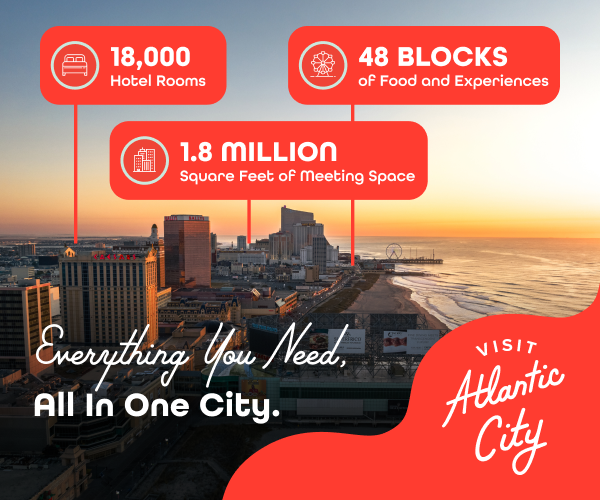
The Role of Digital in Event Strategy

Contributed by: Michelle Bruno (For MPI International)
Nowadays, it’s hard to walk past the boardroom of a trade association or for-profit event organizer without tripping over a conversation on data, technology or the more general topic of digital transformation. The event industry is obviously, and at times painfully, aware that the digitization of event processes and experiences is not only worthy of consideration but also increasingly necessary for sustainability and growth. What remains open to debate, however, are the collective blueprints and best practices of this massive undertaking. Fortunately, those discussions are finally beginning to take shape.
Definitions abound for what it means to transform events digitally. A broad industry consensus has settled around a description that covers developing digital products to augment traditional revenue streams, investing in technology, workflows and processes to develop stronger core events and collecting data to validate exhibitor, attendee and sponsor ROI. From the strategic perspective, consultants and researchers discuss advancing a digital transformation strategy, creating a designated function (such as chief digital officer) at the senior management level and stepping away from a (mostly analog) modus operandi.
Challenges and Opportunities
Speaking regularly at industry events, Denzil Rankine, executive chairman of AMR International, refers to statistics taken primarily from AMR’s annual Globex report. Exhibit space sales (80 percent of the total revenue for most exhibitions) are only growing at about two percent annually (a number substantiated by the Center for Exhibition Industry Research’s 2017 CEIR Index Report). The market value of events, revenue from digital event products and corporate event budgets (in the U.K.) are growing at five percent, 12 percent and 12 percent, respectively.
The numbers reveal an unfolding narrative. With corporate event budgets growing at about 12 percent and the event industry growing at only five percent, “it means there is some leakage out of this industry, firms getting better ROI, perhaps, from elsewhere,” Rankine says. And, even as the growth in traditional revenue sources (exhibit space sales) appears to be slowing down, growth in other revenues, especially digital, is moving at a healthy clip. “It’s up to us as an industry to say, how can we access new growth because by getting new growth, we’re going to be giving our customers what they need,” he adds.
The Role of Data in Event Strategy
Event data is at an inflection point. “This industry has more data than most companies and has data that most marketers would kill for,” says Jean Foster, vice president of marketing for the Consumer Technology Association. Nevertheless, what organizers need, she explains, is a “data-driven strategy.” It should require them to understand their customers’ goals, examine the data they have, develop a roadmap for converting the data into usable insights, focus on the end-to-end attendee experience, leverage event technology and share data with clients.
Despite the abundance of data that third-party event organizers collect, it may not be enough of the right kinds of data. As a “brand-side marketer,” the data that Scott Schenker, vice president, strategic events at ServiceNow, seeks is more comprehensive than attendee demographics and diagnostics—the mainstays of most event organizers. He urges them to query data, such as “what do [buyers] know, what do they think, what are they doing, who are they listening to, what motivates them, what problems do they have and a whole bunch more,” he says.
Schenker also believes that data products can be a ready source of revenue for event organizers. “Increase the sponsor fees and tell them they’re going to get more information,” he suggests. He also proposes bundling event data with data from other sources, such as year-round member activity, and offering it for sale or making it available only to higher-level sponsors of the event or association. Organizers may also consider selling audience data (likes, dislikes, trends, behaviors, etc.) on a subscription basis to industry analysts and firms active in the industry.
Non-traditional Approaches
Digital transformation means experimentation. As digital sales manager for Messe Munich, Vincent Aydin’s job is “to create digital business models that help our exhibitors beyond their extraordinary experience at the show.” His organization uses an “open innovation platform” to address exhibitor challenges (new product use cases or product differentiation inquiries, for example) by crowdsourcing solutions from its show community. “We know who is coming to our shows. We wanted to connect these people with our exhibitors to help them solve problems even when there is no show going on,” Aydin explains.
The Toy Industry Association turned to an online platform to meet the needs of its members. Marian Bossard, senior vice president, global market events at the Toy Industry Association, describes her mission as helping members to “sell more products in more markets more often.” Because of that objective, the rapid evolution of B2C consumer buying behaviors and the shifting habits of the modern toy buyer, the association launched ShopToys365.com. It is “the only toy-based B2B marketplace for the play trade,” she says.
At the four-year mark, ShopToys365 features 500 active sellers (companies that update their showrooms at least every 30 days) and 100 unique buyers visiting 325 seller profiles every day. Besides bridging the gap between the association’s two face-to-face events, it provides the group with a trove of data. “We know what they’re looking for, where they’re visiting and how long they’re lingering and can take that data and use it in a way that can drive business for everyone,” even companies that don’t exhibit at the live events, Bossard says. “ShopToys365 is far more powerful in its reach than we could ever hope to achieve at the [face-to-face] show.”
Increasingly, disruption is digital. Marco Giberti, CEO of Vesuvio Ventures and co-author of The Face of Digital, describes trends that will ultimately change the complexion of the event industry. “We’re starting to see a generation of digital-first event organizers. They are building the digital communities first, and face-to-face events are the second opportunity for them,” he explains. There is also some discussion about how technology can facilitate the move from a digital social network (like Facebook, for example) into a face-to-face community that meets once or twice per year. “There are tons of opportunities and challenges around that,” he says.
Addressing Event Tech Pain
Event technology is crucial for digital transformation. To facilitate the selection and implementation of technology, Mark Bogdansky, senior director, meetings and events for the Auto Care Association, believes that “every department in the organization needs to be working together and talking about how to research and implement technology.” He also recommends consulting with existing technology partners before bringing new technology into the mix, adding a placeholder line item called “conference technology” into the event budget and making sure that sponsors can underwrite any new technology under consideration.
For technology to transform an event, stakeholders have to utilize it. The Association of Equipment Manufacturers (AEM) created an “exhibitor engagement department” to help exhibitors at the CONEXPO/CON-AGG show leverage the technology made available to them. “We took a very personalized approach and created exhibitor personas,” says Megan Tanel, senior vice president of AEM. The association also held exhibitor focus groups, gave exhibitors free access to attendee behavioral tracking tools (if they purchased a basic lead-retrieval package) and resolved to share “everything we learned at the show” with exhibitors, she explains.
Having a strategy for deploying event technology is critically important. Marco Giberti currently follows 25 different categories of event technology. “There are more than 2,000 event-technology companies,” he says. But organizers that implement new technology without an organized strategy of piloting new applications and platforms, building a culture of innovation and adopting a set of management skills to “embrace technology the right way” are destined to “die a death of a thousand cuts,” he explains.
Enhancing the Customer Experience
The way to attendees’ hearts is through digital. According to CEIR’s 2016 Attendee Tool Kit to Enhance the Attendee Experience: Focus Report on Attendee Technology Profile, “Digital is a powerful tool that can enhance the attendee journey—from the moment of deciding there is a need to attend, finding the right event, engaging in pre-event planning, the experience at the event, to follow-up communications at its conclusion.”
According to the report, because most attendees have at least one app on their mobile devices and bring an average of 1.5 devices (mostly smartphones and tablets) with them to the event, “organizers and exhibitors need to pay attention to content to assure it is maximized for every and any type of device.” The report also suggests “an array of features, from mainstream to leading edge, are called for to satisfy the varying palates of today’s attendees.”
Koley Corte, senior vice president and head of digital (Americas) for Reed Exhibitions, advises, “Digital has to be infused across all of our customer touch points. It’s about the customer, not the channel, not about what we want the customer to do. It’s about being prepared for them and being where they want us to be.” That means being “customer first,” aligning technology and digital solutions to the customer journey and addressing customers’ needs with “the right people focusing on the right things with talent, culture and tools,” she says.
Building Technology Infrastructure
One of the factors keeping full digital transformation beyond the grasp of event organizers is the pace with which convention centers can keep up with technology. Despite upgrades to wireless Internet infrastructure to accommodate customers, in-house service providers, security needs and building services, the fast pace with which technology moves compared to the facilities’ budget restraints stymies most centers. And dreams of connected campuses (hotels networked to convention centers) and smart cities require cooperation from multiple entities that is difficult to muster.
There are some things that event organizers can do to push the digital envelope at convention centers. By communicating specific technology requirements to the convention center well in advance of the event, the facility can bring in extra equipment to augment the capabilities they have. Mark Haley, president of Smart City Networks, suggests that convention centers form customer advisory boards and that organizers and convention and visitors bureaus send IT executives to serve on the boards. Some of the larger exhibition organizers and vendors may even be able to subsidize some of the upgrades they need collectively.
The notion that event-industry executives are finally discussing the particulars of digital transformation is a positive step forward. The reality is that exactly zero companies—even those with the most minimal digital commitment—can go back to their analog beginnings now. Customer preferences, consumer behaviors, millennial influences, market forces and other industries that have been disrupted and depleted all point in the direction of digital. It’s no longer a question of whether digitization is the most appropriate next step for the industry, but how to get the job done.


Leave a commentOrder by
Newest on top Oldest on top